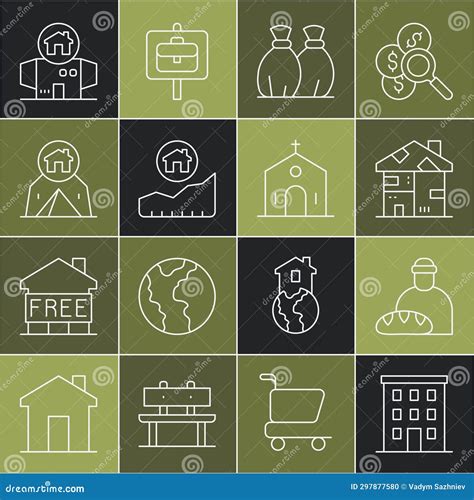Imagine a world where homes are not simply structures made of bricks and mortar, but rather innovative spaces built from unconventional materials with a profound commitment to sustainability and affordability. In this realm, dwellings take on a different character, one that challenges conventional norms and embraces creativity to the fullest.
Within this landscape of unconventional housing solutions, an intriguing and surprising concept has emerged – the idea of living in a home made entirely out of repurposed cardboard. This seemingly simplistic material captivates the imagination, presenting an opportunity for the creation of functional and environmentally-friendly dwellings that could transform our perception of home and community.
Upon cursory examination, the notion of a cardboard house might evoke preconceived notions of fragility and impermanence, but this couldn't be further from the truth. Out-of-the-box thinkers have harnessed the potential of this versatile material, exploring its durability, adaptability, and suitability for long-term living. Through ingenious design and engineering, these cardboard structures stand as a testament to the untapped potential of sustainable housing solutions.
The Allure of Cardboard: A Rising Trend in Cost-Effective Housing

As the pursuit of more sustainable and budget-friendly housing options gains momentum, a fascinating new trend is emerging: the utilization of cardboard as a viable material for constructing homes. This innovative approach is capturing the attention of individuals and communities around the world due to its unique blend of affordability, creativity, and environmental consciousness. By exploring the potential hidden within humble cardboard, a promising path toward creating habitable shelters that are both aesthetically pleasing and economically accessible is unveiled.
1. Lightweight and eco-friendly: Cardboard, a versatile and lightweight material, offers numerous benefits in the realm of affordable housing. Its structural integrity, combined with its eco-friendly nature as a recyclable and biodegradable substance, makes it an exceptional choice for those seeking sustainable and responsible living solutions. |
2. Cost-effective and customizable: One of the most significant advantages of cardboard housing lies in its low cost. Compared to traditional construction materials, cardboard is a fraction of the price, allowing for more accessible housing options for individuals and families with limited financial resources. Furthermore, the customizable nature of cardboard construction facilitates personalized and unique designs, enabling homeowners to create spaces that reflect their individuality and style. |
3. Surprising durability: Contrary to common misconceptions, cardboard can indeed be remarkably durable when properly treated and reinforced. Through techniques such as lamination, waterproofing, and the addition of protective coatings, cardboard structures can withstand the elements and provide a secure living environment. Additionally, due to its lightweight nature, cardboard homes are more earthquake-resistant, making them especially suitable for areas prone to seismic activity. |
4. Promoting creativity and innovation: The use of cardboard in housing construction encourages architects, designers, and individuals to think outside the box and push the boundaries of what is considered conventional. The malleability of cardboard allows for endless possibilities in terms of shapes, forms, and architectural experimentation. This fresh approach stimulates creativity and fosters a sense of innovation, ultimately resulting in unique and visually captivating dwellings. |
Embracing Sustainability and Minimalism
Within the context of the broader theme of affordable and creative living solutions, it is essential to explore the notion of embracing sustainability and minimalism. This section focuses on the idea of living a more eco-friendly and simplified lifestyle, without relying on traditional housing options.
By embracing sustainability, individuals can strive to minimize their environmental impact and live in harmony with the natural world. This can be achieved through various means such as incorporating renewable energy sources, reducing waste and consumption, and using eco-friendly materials. Sustainability extends beyond the mere construction of a dwelling, encompassing a holistic approach to everyday living choices.
Similarly, minimalism emphasizes the idea of consciously reducing material possessions and prioritizing experiences over material goods. Living in a cardboard house exemplifies the essence of minimalism, as it challenges traditional notions of what constitutes a home and encourages individuals to simplify their lives. By embracing minimalism, individuals can focus on what truly matters, leading to a more fulfilling and intentional lifestyle.
Furthermore, adopting sustainable and minimalist practices has a multitude of benefits. It not only reduces our ecological footprint and promotes resource conservation but also results in financial savings due to lower consumption and maintenance costs. Additionally, living in a smaller space fosters a sense of community and encourages social interactions, as it often necessitates shared spaces and resources.
In conclusion, embracing sustainability and minimalism presents an alternative approach to living, offering a way to reduce our impact on the environment while simplifying and enriching our lives. By exploring innovative solutions like cardboard houses, individuals can create unique, eco-friendly homes that reflect their values and aspirations.
Creating a Home on a Limited Budget

In this section, we explore the concept of building a comfortable dwelling without the need for substantial financial resources. We will delve into innovative and economical approaches to crafting a cozy living space that accommodates various needs and tastes.
1. Crafting a Budget-Friendly Oasis:
- Discovering affordable materials
- Maximizing resourcefulness
- Implementing cost-saving measures
2. Innovative Small-Space Designs:
- Exploring compact living ideas
- Utilizing multi-functional furniture
- Optimizing storage solutions
3. Sustainable and Eco-Friendly Approaches:
- Embracing eco-conscious construction techniques
- Incorporating renewable energy sources
- Minimizing environmental impact
4. DIY Home Decor on a Limited Budget:
- Repurposing and upcycling furnishings
- Enhancing interiors with low-cost decorations
- Creating personalized artwork
By exploring these aspects, individuals seeking to establish a home within a limited budget can uncover creative and resourceful solutions, ultimately achieving a comfortable and inviting living space without compromising financial stability.
Unveiling the Potential: The Versatility of Cardboard Structures
Exploring the Boundless Applications of Cardboard in Construction
Cardboard, a material often overlooked in the realm of construction, holds immense potential when it comes to creating versatile and innovative structures. The possibilities of utilizing cardboard in various architectural projects are vast, offering a cost-effective and sustainable alternative to traditional building materials.
From temporary shelters to large-scale installations, cardboard structures have been utilized in numerous contexts around the world. This versatile material can be shaped, cut, and manipulated in ways that allow for intricate designs and unique architectural creations.
Cardboard's lightweight nature and ease of transport make it a practical choice for temporary and mobile structures. Its durability and strength, coupled with its ability to withstand different weather conditions, have made it suitable for eco-friendly housing solutions and disaster relief efforts.
Furthermore, cardboard structures demonstrate great potential as exhibition displays, pop-up shops, and artistic installations. Their eco-friendly appeal and aesthetic charm make them an attractive choice for businesses and artists looking to make a bold statement.
When it comes to sustainability, cardboard structures take the lead. Made from recycled materials and being easily recyclable themselves, they offer a greener alternative to traditional construction methods. Their low carbon footprint, coupled with their affordable production costs, make them a viable option for environmentally-conscious builders.
As the world continues to seek innovative and sustainable solutions for building and living spaces, it becomes increasingly crucial to explore the full potential of materials like cardboard. Its versatility and eco-friendliness open up a world of possibilities for architects, designers, and individuals seeking affordable and creative living solutions.
FAQ
Why would someone want to live in a cardboard house?
Living in a cardboard house offers a unique combination of affordability, creativity, and sustainability. The material is readily available and inexpensive compared to traditional building materials such as wood or concrete. It is also lightweight, making it easy to transport and assemble. Additionally, living in a cardboard house allows individuals to express their creativity by customizing and designing their own living space. Lastly, the use of cardboard promotes sustainability as it is a recyclable material.
Are cardboard houses durable enough to withstand harsh weather conditions?
Cardboard houses are designed to be durable and provide ample protection against various weather conditions. While cardboard may seem flimsy, it can be reinforced with waterproof coatings, strong adhesives, and multiple layers to provide better insulation and stability. These houses have been tested to withstand heavy rain, snow, and moderate winds. However, they may not be suitable for areas prone to extreme weather like hurricanes or tornadoes.
What are the potential disadvantages of living in a cardboard house?
Living in a cardboard house is not without its challenges. Firstly, cardboard is not as sturdy as traditional building materials, making it more susceptible to damage from accidents, vandalism, or pests. Extreme weather conditions can also pose a risk, as cardboard houses may not provide as much insulation as conventional houses. Another disadvantage is the limited lifespan of cardboard, as it may deteriorate over time due to exposure to moisture or sunlight. Additionally, finding suitable land or legal restrictions may pose obstacles for those interested in building a cardboard house.



